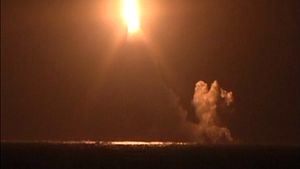A Russian Navy nuclear-powered ballistic missile submarine (SSBN) test fired a Bulava (RSM-56) intercontinental ballistic missile (ICBM) from a submerged position in the Barents Sea off the northern coast of Russia this week, the Russian Ministry of Defense announced.
“The Project 955 Borei-class underwater missile cruiser Yuri Dolgoruky has made a successful launch of a Bulava intercontinental ballistic missile from the designated area of the Barents Sea towards the Kura practice range in Kamchatka. The launch was made from the submerged position in compliance with a combat training plan,” the Defense Ministry said.
“The parameters of the Bulava intercontinental ballistic missile’s flight trajectory were practiced in the normal regime. According to the confirmed data of the registering equipment, the warheads of the intercontinental ballistic missile performed a full cycle of the flight and successfully hit the designated targets at the practice range,” the ministry added.
The last test firing of Bulava ICBMs took place on September 27, when the Project 955 Borei-class Yuri Dolgoruky test fired two missiles from a submerged position in the White Sea off the northwest coast of Russia (See: “Russia’s Deadliest Sub Test Fires 2 Nuclear-Capable Ballistic Missiles”). While one missile successfully hit its target, the second missile self-destructed shortly after takeoff.
The Russian Navy test-launched two Bulava ICBMs in November 2015. The missiles, launched from the Borei-class SSBN Vladimir Monomakh, reportedly successfully hit their targets in the Kamchatka region in Russia’s Far East. “Since 2004, the missile has been tested 25 times, with varying degrees of success,” I explained elsewhere. “The last five test conducted between September 2014 and September 2016, were reportedly all successful.” As I reported previously:
Each Borei-class SSBN can carry from 12 to 16 Bulava (RSM-56) intercontinental ballistic missiles (ICBM)–a sea-based variant of the Topol-M SS-27–armed with 6-10 warheads per missile. Consequently, one submarine can carry between 72 to 160 hypersonic, independently maneuverable warheads, yielding 100-150 kilotons apiece. The Bulava missile purportedly has a range of over 8,300 kilometers (5,157 miles) and is specifically designed to evade Western ballistic missile defense shields. The new ICBM is intended to be the cornerstone of the sea-based component of Russia’s nuclear triad.
The Yuri Dolgoruky and Vladimir Monomakh, both Project 955 Borei-class (“North Wind”) aka Dolgoruky-class nuclear-powered ballistic missile submarines, belong to the first new class of Russian boomers since the end of the Soviet Union. The new class of subs is slated to replace Project 941 Typhoon-class and Project 667 BDRM Delta IV-class SSBNs in the coming years. Russia has also been working on an improved variant of the Project 955 Borei-class, the Project 955A Borei II-class, which will be capable of carrying up to 20 Bulava ICBMs in comparison to the 16 of the original Borei-class.






























